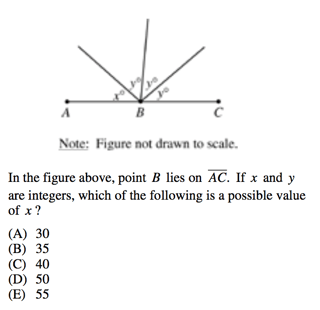
The benefits to standardized testing are two-fold: almost all of the questions are multiple choice, and you do not have to show your work. Why are these benefits to you? Unlike in your math classes, where it is crucial to show your work in order to prove that you know how to solve problems, neither the SAT nor the ACT cares about how you got to your solution. All standardized tests measure is whether or not you have the correct answer.
This means that finding the right answer—no matter the process—is your only goal. There is no such thing as partial credit on standardized testing, but there are plenty of workarounds that can help you to find the correct answer without making you do overly complicated math. This guide will take you through one of simplest processes for working out the answers to several different kinds of standardized math questions—plugging in the answer choices.
In this guide, we'll give you a complete walk through on the strategy of plugging in the answers (PIA)—why use it, how to use it, and when to use it on your standardized test(s). The other best strategy for working around problems—plugging in your own numbers—is covered in a separate guide.

Think of using PIA as your fully-sanctioned ace in the hole.
Why Use Plugging in Answers?
Sometimes you may find yourself confronted with a problem that you have no idea how to approach. Sometimes you may just think it will take too long to solve the problem algebraically. Other times, you may just want to be sure—absolutely sure—you have the right answer and didn't miss a parentheses or a negative sign or any other small piece of your equation(s) somewhere along the line. When this happens, plugging in the answers will often get you to the correct answer choice.
Even before you begin to approach the problem, look at your answer choices. If you look to the answers first (instead of trying to work out the problem from scratch), you will already know the range in which the correct answer should fall.
Considering both the ACT and the SAT are standardized tests, one of the four (SAT) or five (ACT) answer options you are given will be 100%, unquestionably correct. So if your answer range spans from 2-30, you know the correct answer cannot possibly be 45.
This may seem obvious, but, in the stress of the testing environment, it can be very easy to forget that one answer choice must be absolutely correct and that you can use this information to your advantage. So remember to take a deep breath as you go through the test; you have other avenues available to you besides trying to solve each question from scratch.

It can be easy to become disoriented during the testing process. Try to maintain a level head and pay attention to how you can use shortcuts to make the testing process easier.
How to Use Plugging in Answers
Now that you know that plugging in answers (PIA) can be an asset to your test-taking, let's go through exactly how to do it.
The basic premise of PIA is simple—use the answers that you are given and plug them back into the original equation or information.
If $x$ is a positive integer such that ${x + 1}/{2^x} = 3/16$, what is the value of $x$?
A. 1
B. 2
C. 3
D. 4
E. 5
So we are trying to solve for our one variable, $x$. This problem looks like it would be difficult and time consuming to try it algebraically, so let's simply use the answers we are given as potential $x$ values and plug them back into the original equation in place of $x$.
So let's first begin with answer choice A, 1.
${x + 1}/{2^x}$
${1 + 1}/{2^1} = 2/2 = 1$
$1 ≠ 3/16$
Answer A is incorrect, $x$ cannot equal 1.
Now let's try answer choice B.
${x + 1}/{2^x}$
${2 + 1}/{2^2} = 3/4$
$3/4 ≠ 3/16$
Answer B is incorrect, $x$ cannot equal 2.
Time for answer choice C.
${x + 1}/{2^x}$
${3 + 1}/{2^3} = 4/8 = 1/2$
$1/2 ≠ 3/16$
Answer C is incorrect, $x$ cannot equal 3.
So let's try answer choice D.
${x + 1}/{2^x}$
${4 + 1}/{2^4} = 5/16$
$5/16 ≠ 3/16$
Answer D is incorrect, $x$ cannot equal 4.
Now, if we have done all the other calculations correctly, our answer must be E by default, but let's double-check to be sure.
${x + 1}/{2^x}$
${5 + 1}/{2^5} = 6/32 = 3/16$
$3/16 = 3/16$
This means our final answer is E, 5.
You can see here that the above took a little bit of time, since we began our plugging in with option A and our answer was ultimately E. So how can we shorten the time it took to check every answer until we got to the right one?
Fastest Way to Use PIA
While taking any kind of standardized test, our two main test objectives are always:
#1: Find the right answer
#2: Do so in the shortest amount of time (in order to answer as many questions as possible)
Because PIA can take some time, we need to find ways to fast-track the process. So look to the problem above and think about why it took so long. Well, for one, we tested every option in order and we didn't find the right answer until option E.
Now imagine if we had instead started with answer choice C.
Notice that the test always presents you with answer choices in order from least to greatest (or, on rare occasions, greatest to least). But no matter which direction they go in, the answers are always in order. This can help you narrow down your time for a PIA question by starting in the middle and using process of elimination.
For example, if we had started with answer option C in the above question, we would have seen that the denominator (8) was far too small. We would have been able to eliminate C, of course, but we also would have been able to eliminate A & B because their denominators (found by $2^x$) would be even smaller. If option C had too small of a denominator here, the smaller answer choices of A and B would have given denominators that were even smaller.
Now your options are reduced to D and E, which is a much narrower range of choices to test.
Sometimes, however, starting from C is not as straightforward as this.
In the case above, our answer and equation had an inverse relationship (that is, when one increases, the other decreases). This can sometimes make it difficult to determine right away if you should eliminate the options larger than C or the options smaller than C. Because we focused on the denominators in this case, we could see that we were able to eliminate answer choices less than C.
Generally, it is much easier to determine which options to eliminate if your answers and your equation have a direct relationship (when one increases, the other increases).
But if it happens and you cannot tell whether to eliminate A/B or D/E in addition to C, try one and see. Did you try B and the answer was even further off? Eliminate A, B, and C. Did you try E and the answer was way off track? Eliminate C, D, and E.
Even when you are not sure of the relationship—direct or inverse—between your answer and equation, you will still be able to eliminate one answer choice without trying it directly, and will thus save yourself some time.
Bottom line—when using PIA, start in the middle (C) and try to eliminate any answer choices you can. Answer can't be negative? Eliminate the negatives! Problem has to have a large numerator? Get rid of the answer choices with small numerators! The better you can get at narrowing down your answer options, the fewer answers you have to test when using PIA.
 Whenever an answer doesn't seem to fit, get rid of it!
Whenever an answer doesn't seem to fit, get rid of it!
Now let's go through a few more real ACT and SAT math examples to demonstrate PIA in action.
If $x$ and $y$ are positive integers, what are all the solutions $(x,y)$ of the equation $3x+2y=11$?
A. $(1,4)$ only
B. $(3,1)$ only
C. $(1,4)$ and $(2,2)$
D. $(1,4)$ and $(3,1)$
E. $(2,2)$ and $(3,1)$
Let's, as always, start with option C.
We are first given $(1, 4)$ for $x$ and $y$ respectively, so let's plug those into the original equation.
$3x + 2y = 11$
$3(1) + 2(4) = 11$
So $(1, 4)$ works. This means we can eliminate answer choices B and E, as neither of those contain $(1, 4)$ as an option.
Now let's try our other option for C, $(2, 2)$:
$3x + 2y = 11$
$3(2) + 2(2) = 10$
$(2, 2)$ does NOT work, so we can eliminate answer choice C. So far, we have eliminated answer choices B, C, and E.
We are now down to two options—A and D. We already know that $(1, 4)$ works, so let us try $(3, 1)$ from answer choice D.
$3x + 2y = 11$
$3(3) + 2(1) = 11$
$(3, 1)$ works to fulfill our equation.
This means our final answer is D, $(1, 4)$ and $(3, 1)$.
If 13 is added to one-half of a certain number, the result is 37. What is the original number?
A. 24
B. 40
C. 48
D. 61
E. 80
We are tasked with finding the original number, so each of these answer choices are the original number.
First, our original number is divided in half. So let us begin with option C again.
$48/2 = 24$
Next, we add 13.
$24 + 13 = 37$
We have found our right answer—no need to test any other option.
Our final answer is C, 48.

Because it can take extra time, you've got to pick and choose when to use PIA. So let's solve that mystery. (Zoinks!)
When to Use Plugging in Answers
As you can see in the above demonstrations, the benefit to using PIA is that it can function both as your method of solving for your answer and as your way to double-check that your answer is correct. The drawback is that using PIA can take longer than using pure algebra.
$3x+2y+2x = 19$
$3x+y+z=14$
If the equations above are true, which of the following is the value of $y+z$?
A. -5
B. -4
C. 0
D. 4
E. 5
Take this problem, for example. You could either solve this using algebra or using PIA. Let's look at how long each one takes.
PIA Method
Our answer choices are a replacement for $y + z$. So let us again start with C.
We have $(y + z)$ in the second equation, so let us replace it there.
$3x + y + z = 14$
$3x + 0 = 14$
$3x = 14$
Now, take that value for $3x$ and replace it in the first equation. (We do not need to find the value for $x$ alone (4.67), as $3x$ is repeated in the top equation.)
$3x + 2(y + z) = 19$
(Why did we re-write $2y + 2z$ as $2(y + z)$? Because we could distribute out the common 2 and keep our $y + z$ intact)
$14 + 2(0) = 14$
$14 ≠ 19$
So C is not correct.
We can extrapolate from the problem that $y + z$ will not be negative. Why? Because $3x$ remains the same and yet the solution is greater when $y + z$ is doubled. Therefore, $y + z$ must be positive, as a negative $y + z$ would mean that the top equation would have a solution that was smaller than that of the bottom equation.
So let's try option D next.
$3x + y + z = 14$
$3x + 4 = 14$
$3x = 10$
Again, we do not need to find the individual value for $x$ (3.33), because $3x$ is repeated in the top equation.
So $3x + 2(y + z) = 19$
$10 + 2(4) = 18$
$18 ≠ 19$
So D is not correct.
Let us now try option E.
$3x + y + z = 14$
$3x + 5 = 14$
$3x = 9$
Now let us plug in this value for $3x$ in the top equation.
$3x+ 2(y + z) = 19$
$9 + 2(5) = 19$
$19 = 19$
So our final answer is E, $y + z = 5$
Now let's look at how long the problem would have taken had we used algebraic methods instead of PIA.
Algebra Method
We have two equations:
$3x + 2y + 2z = 19$
$3x + y + z = 14$
By the using subtraction, we can simply subtract the bottom equation from the top equation.
$[3x + 2y + 2z = 19] - [3x + y + z = 14]$
$3x - 3x = 0$, so the $x$'s cancel out.
$2y - y = y$, so we are left with $y$
$2z - z = z$, so we are left with $z$
$19 - 14 = 5$, so our final solution is 5
This leaves us with a final solution of:
$y + z = 5$
Which again gives us our final answer E, $y + z = 5$
As you can see, sometimes using PIA can make a problem take much longer than it would using algebra. How you complete your math section(s) depends completely on your pacing and your level of math knowledge and comfort.
If you generally have a lot of spare time per section, then go ahead and use PIA! It may even save you time going back and double-checking your work (though it never hurts to be extra sure and double-check anyway).
If, however, you find yourself running short on time, you may want to save using PIA for these circumstances only:
#1: You cannot find a way to solve the problem without using PIA
If you come across a problem and have no idea how to approach it from word one, definitely use PIA! If you forget a math rule or equation, you can get to the correct answer with PIA. Often, you won't have to know the rules for manipulating roots, means, or shapes if you can circumvent the question entirely by going straight to the answers.
There may also be an occasional problem that cannot be solved without using PIA.

For a problem like this, you literally cannot answer it without looking to the answers. If you tried to solve it with pure algebra, you would get to:
$x + y + y + y = 180$
$x + 3y = 180$
But now what? We have no more information in the problem itself, so we MUST look to the answers.
So let's first take the information we are given.
We know that a line = 180°. We also know that an integer is a whole number. This means that $180 - x = \a \number \divisible \by \3$. (Why 3? Because there are 3 equal $y$º segments.)
So let's use our answers, starting as usual with C.
$180 - 40 = 140$
140 is NOT divisible by 3. We must look to another answer choice.
Because this question does not rely on numbers increasing or decreasing (all we are looking for is a remainder divisible by 3), we cannot eliminate any other answer choices other than the ones we've tried.
We can, however, make life easier by testing the $x$-values that end in 0 first. Why? Because this is easier to subtract from 180 quickly. If these don't work, we can try answer choice B and E.
So let's try answer D.
$180 - 50 = 130$
130 is not divisible by 3.
So let's try A.
$180 - 30 = 150$
$150/3 = 50$
We have found a solution divisible by 3. We can stop here. The degree measures could be: 30, 50, 50, 50.
So our final answer is A, 30.
#2: You have enough spare time that you can spend the extra on PIA
If you've gone quickly (but still accurately!) enough through earlier sections, go ahead and let yourself have the extra seconds per question that PIA uses. Though the difference between an algebraic solve and a PIA solve is often nothing more than 30 seconds, that time can add up fast. Always be sure you are using your time to your best advantage to get the most points possible across the board.
If you feel you are completely running short on time, however, check out our articles on how to buy yourself extra time on both the SAT and the ACT.
#3: You want to double-check your answer
PIA can often act as its own question double-checker. This can sometimes help off-set the extra time PIA eats up, but don't always count on this.
Because you found the answer using the answers provided, you don't have to plug it back into the equation to make sure it works—you already know it works! You've both solved your question and double-checked to make sure it was accurate all in one.
Given the equation $x^2 - 2x - 8 = 0$, which answer choice is a possible value for $x$?
A. -8
B. -6
C. 0
D. 2
E. 4
You can solve the problem by way of factoring the quadratic equation you are given:
$x^2 - 2x - 8 = 0$
$(x + 2)(x - 4) = 0$
But what if you were not sure where to go from here? Answer choice D might look awfully tempting if you didn't know you were supposed to set each factor to 0 to find your final solutions for $x$.
If you thought you were supposed to stop here and so thought that your answer should be D, now would be the time to double-check it by plugging it back into the original equation.
$x^2 - 2x - 8 = 0$
$2^2 -2(2) - 8$
$4 - 4 - 8 = -8$
Uh-oh! Answer choice D doesn't work. It must mean something went wrong.
If you were to continue to use algebra to complete the problem, the correct way to finish would be:
$(x + 2) = 0$
$x = -2$
But if you didn't know how to complete this last step of the problem (or if you were simply going through the test too fast—an all too common occurrence on a standardized test), and you didn't check your work, then it can be easy to choose the wrong answer.
Now let's set the second factor to 0:
$(x -4) = 0$
$x = 4$
So your two values for $x$ are -2 and 4, which means that your final answer is E, 4.
If you wanted to make sure you had the right answer (because careless errors are easy to make), then you would plug this number back into the original equation to double-check.
So $x^2 - 2x - 8 = 0$
$4^2 -2(4) - 8$
$16 - 8 - 8 = 0$
4 is correct. You can continue to the next problem with confidence.
Now, let's look at the same problem using PIA.
To save us time, let us imagine that you have tried your other answer options and have now narrowed your choice down to E.
So let us try answer E.
$x^2 - 2x - 8 = 0$
$4^2 - 2(4) -8$
$16 - 8 - 8 = 0$
You have found the right answer and don't even have to double-check to make sure it's correct. You have circumvented the need to plug the answer back in to check your work, because that is how you found the answer in the first place.
So your final answer is E, 4.
#4: You feel that you may have found the wrong answer using algebraic methods
Maybe you started in on the question right away with algebra and got halfway through before you felt that you had taken a wrong turn somewhere. Maybe the algebra equation you set up spit out an answer that didn't come close to any that were provided (or worse—maybe the answer you found was just slightly off).
This means it's probably a good idea to switch your method and try using PIA on this question.
#5: The question lies in a question range in which you have previously made several errors
If you have taken a practice SAT or ACT and discovered that you generally start to make mistakes around the halfway or three-quarter mark, switch your tactics to PIA instead of algebraic methods in this section in order to increase your score.
It can be slower, but it will be more accurate and you won't have to spend as much time double-checking your work.
 There is always a balancing act when taking a standardized test. You will have to weigh your timing against your accuracy in whichever way makes sense to you personally.
There is always a balancing act when taking a standardized test. You will have to weigh your timing against your accuracy in whichever way makes sense to you personally.
Can I Always Use Plugging in Answers?
Unfortunately some questions can NOT be solved by plugging in answers. The best way to tell if you can use PIA on a question is to look and see if your answer choices are in numerical form—integers, fractions or decimals. When your answer options are numbers, you can most likely use PIA.
If, however, your answers use variables (or even if the question itself involves several variables), then your best bet is probably to use the strategy of plugging in your own numbers.
Most questions (though not all) can be solved using one of these two ACT/SAT math strategies. To see the broad range of question types that both PIA and PIN can cover, definitely check out our guide on plugging in your own numbers.
But for now, let's look at some real SAT and ACT math examples that can all be solved with PIA:
Test Out Your Knowledge
1.
6, 10, 18, 34, 66
The first number in the list above is 6. Which of the following gives a rule for finding each successive number in the list?
A. Add 4 to the preceding number.
B. Take $1/2$ of the preceding number and then add 7 to that result.
C. Double the preceding number and then subtract 2 from that result.
D. Subtract 2 from the preceding number and then double that result.
E. Tripe the preceding number and then subtract 8 from that result.
2.
If $n$ and $k$ are positive integers and $8^n=2^k$, what is the value of $n/k$?
A. $1/4$
B. $1/3$
C. $1/2$
D. 3
E. 4
3.
What is the least common denominator for adding the fractions $4/15$, $1/12$, and $3/8$?
A. 40
B. 120
C. 180
D. 480
E. 1,440
4.
The perimeter of a parallelogram is 72 inches, and 1 side measures 12 inches. What are the lengths, in inches, of the other 3 sides?
A. 12, 12, 36
B. 12, 18, 18
C. 12, 24, 24
D. 12, 30, 30
E. Cannot be determined from the given information
Answers: C, B, B, C
Answer Explanations:
1. We could try to find this pattern ourselves, but why bother when we have answer options that we can test?
So let's look at each answer option. In this case, starting with C will not give us an advantage in terms of being able to cross out multiple options in one blow, but let us still start with C to help us remember to keep our PIA strategy consistent.
Answer choice C says: "Double the preceding number and then subtract 2 from that result."
So let's see if this applies to our list.
6, 10, 18, 34, 66
$(6 * 2) - 2 = 10$
So far so good, but remember to test out more than just the first pair of numbers.
$(10 * 2) - 2 = 18$
So far so good! Let's try the last pair of numbers to save ourselves time from testing them all, but still confirm if the pattern holds true.
$(34 * 2) - 2 = 66$
Success! We have found the right answer on the first try. We can stop here.
Our final answer is C.
(If you are unconvinced that C is the right answer, go ahead and try a few of the other options! Answer choice E says "triple the preceding number and subtract 8 from that result." Well that works with the first pair of numbers, as $(10 * 3) - 8 =18$, but it doesn't continue to work. $(18 * 3) - 8 = 46$. The pattern breaks, and the question says that it must hold true for the entire list.)
2. We are given $8^n = 2^k$ and must find $n/k$. You can solve this problem in a number of ways, but let's try it using PIA.
So if we start with answer choice C, we would have:
$n/k = 1/2$, so $n = 1$ and $k = 2$
Now let's plug those values into our original equation.
$8^n = 2^k$
$8^1 = 8$
$2^2 = 4$
$8 ≠ 4$, so C is not the correct answer.
But now we know that we need a larger value for $k$. Even when n was as small as 1, our $k$ needed to be greater than 2. So We can eliminate answer choices C, D, and E. (Why? Because choices D and E are both whole numbers, which would mean their denominators are both 1. This would mean $2^1 = 8^n$ which would never be true.)
So let us now try answer B.
$n/k = 1/3$, so $n = 1$ and $k = 3$
Now let's plug those values into our original equation.
$8^n = 2^k$
$8^1 = 2^3$
$8^1 = 8$
$2^3 = 8$
$8 = 8$
The equation is correct. This means our final answer is B, $1/3$
3. We are being asked to find the least common denominator in this question. This is unusual, so we will have to alter our normal PIA strategy. Because we need to find the smallest common multiple (not just any common multiple), we will start with the smallest answer option, A.
We are looking for a common multiple of 15, 12, and 8.
Only 8 goes evenly into 40, so A cannot be the correct answer.
Let us try B.
$120/15 = 8$
In one blow, we have determined that both 8 and 15 can go evenly into 120, as $15 * 8 =120$
$120/12 = 10$
Because each number went evenly into 120 and there were no options smaller than 120, this means B is correct.
Our final answer is B, 120.
4. We know that a parallelogram has 4 sides with 2 equal pairs of opposite sides (if you are not familiar with this kind of geometry problem or figure, check out our guide on planar geometry).
This means we can immediately eliminate answer choice A. Why? Because we already have one known side of 12. Answer choice A would give us a parallelogram with three equal sides and one outlier, which is not a proper parallelogram.
We also know that we have one known side and a perimeter. This means we can eliminate answer choice E, as we have enough information to solve the problem.
We are down to options B, C, and D.
So let's start with C.
We are given a side length of 12 already, so let us add that side to answer choice C.
$12 + 12 + 24 + 24 = 72$
Whoo, we're done! We have two sets of parallel sides whose perimeter adds up to 72.
So our final answer is C, 12, 24, 24.
 Though using PIA may seem arduous in these examples, you will likely be able to finish them much faster. For the sake of clarity, we have broken down each problem into more steps than you would take yourself.
Though using PIA may seem arduous in these examples, you will likely be able to finish them much faster. For the sake of clarity, we have broken down each problem into more steps than you would take yourself.
The Take-Aways
The strategy of plugging in the answers can be invaluable if you find yourself confronted with a problem you don't know how to solve or if you want to make absolutely sure you have the correct answer. The drawback, however, is that PIA can eat up extra time.
But if you make sure to use your strategies wisely and save them for times in which you need them most, you will likely find yourself solving problems you were never able to before.
What's Next?
Whew! Now that you've gone through how and when to use PIA, make sure you know the other techniques for navigating standardized math questions. So be sure to check out our article on plugging in numbers (PIN) to get a complete picture for how to circumvent using complex algebra on the SAT and ACT.
Running out of time on ACT or SAT math? Look no further than how to buy time on SAT math and how to buy time on ACT math.
Think you might need a tutor? Check out how to find the right math tutor for you and how to decide whether to use online or in-person tutoring.
Want to get a perfect score? Check out our article on how to get an 800 on the SAT math section and how to get a 36 on the ACT math section, both written by a perfect scorer.
Want to improve your SAT score by 160 points or your ACT score by 4 points? We've written a guide for each test about the top 5 strategies you must be using to have a shot at improving your score. Download it for free now:
Have friends who also need help with test prep? Share this article!

Courtney scored in the 99th percentile on the SAT in high school and went on to graduate from Stanford University with a degree in Cultural and Social Anthropology. She is passionate about bringing education and the tools to succeed to students from all backgrounds and walks of life, as she believes open education is one of the great societal equalizers. She has years of tutoring experience and writes creative works in her free time.



































 Holly R.
Holly R.